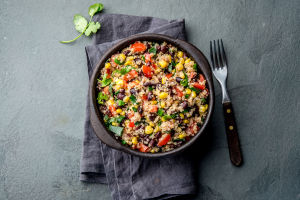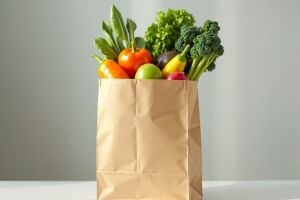Did you know that around one-third of all food produced globally is wasted? That's not just bad news for the environment—it's also a waste of money, energy, and time.
But the good news is that it's easy to make a difference starting right in your own kitchen. Cooking without waste isn't about being perfect. It's about being thoughtful and intentional with the food we buy, prepare, and consume.
Even small changes in how we handle food can add up to a big environmental impact over time.
According to the Food and Agriculture Organization (FAO), reducing food waste is one of the top ways individuals can fight climate change. When we throw food away, we're also wasting the water, land, and labor used to produce it. A zero-waste kitchen helps cut down on these hidden losses—and saves money at the same time.
Start with Smarter Shopping
Every zero-waste kitchen begins before you even pick up a pan. It starts at the grocery store. The key is buying only what you need and planning your meals ahead of time. Before heading out, make a shopping list based on your weekly menu. Take a quick inventory of your fridge and pantry to avoid doubling up on items you already have.
Choose loose produce rather than pre-packaged fruits and vegetables whenever possible. Bring your own reusable bags and containers to reduce unnecessary packaging. Buying in bulk is also a smart way to minimize waste and save money, especially for items like grains, nuts, and spices.
Store Food the Right Way
Improper storage is one of the biggest reasons food goes bad before we use it. By learning how to store food correctly, you can extend its shelf life and avoid unnecessary waste. For instance, keep herbs in a glass of water like flowers, wrap leafy greens in a damp cloth, and store onions and potatoes separately to keep them from spoiling too fast.
Label leftovers and prepped ingredients with the date they were made or opened, and keep older items toward the front of the fridge or pantry so you use them first. Transparent storage containers also help you see what's available, reducing the chances of forgotten food turning into trash.
Use Every Part of the Ingredient
One of the most powerful zero-waste habits is learning to use every part of your ingredients. Carrot tops, broccoli stems, herb stems, and citrus peels all have surprising culinary uses. For example, carrot greens can be turned into pesto, citrus peels can be zested or candied, and broccoli stems can be shredded for stir-fries or slaws.
Vegetable scraps, bones, and herb trimmings can be saved in the freezer and used to make homemade stock. This not only reduces waste but also adds rich flavor to your soups, grains, and sauces. Banana peels and apple cores, surprisingly, can be used in smoothies, teas, or even homemade vinegar.
Get Creative with Leftovers
Leftovers don't have to be boring. In fact, they're a great opportunity to be creative in the kitchen. Leftover roasted vegetables can be turned into soup or frittatas. Extra rice can become fried rice or rice pudding. Stale bread can be transformed into croutons, breadcrumbs, or French toast.
One helpful habit is to have a designated "eat me first" shelf in your fridge where you place ingredients or meals that need to be used soon. This simple system makes it easier to keep track of what's about to expire and gives you daily inspiration for quick meals.
Composting: A Smart Final Step
No matter how careful we are, there will always be some food waste—like eggshells, coffee grounds, or avocado skins. Composting is the eco-friendly way to return these scraps to nature instead of sending them to the landfill. Home compost bins come in all sizes, including indoor-friendly options for small kitchens.
According to the Environmental Protection Agency (EPA), composting not only reduces landfill use but also improves soil health and reduces greenhouse gas emissions. If you don't have space to compost at home, many communities offer local compost drop-off sites or collection services.
Rethink Packaging and Single-Use Items
Waste in the kitchen doesn't stop with food. Plastic wrap, disposable containers, and packaging also add to the problem. One step toward a zero-waste kitchen is investing in reusable alternatives. Beeswax wraps, silicone lids, and glass storage containers are durable, practical, and better for the environment.
Avoid buying individually packaged snacks or ingredients when you can purchase in bulk. Choose products with minimal or recyclable packaging. Many stores now offer refill stations for pantry items and cleaning products, helping you reduce packaging waste even further.
Meal Prep with Purpose
Meal prepping helps prevent waste by making it easier to use ingredients efficiently. When you prepare meals or ingredients in batches, you can plan around what you already have and reduce forgotten leftovers. Cooking in batches also saves time during busy weeks.
Try prepping vegetables, grains, or proteins ahead of time and storing them separately. You can mix and match components throughout the week into fresh meals without repeating the same dish. This method reduces waste and keeps your menu exciting.
Teach and Involve the Whole Family
A zero-waste kitchen works best when the whole household is involved. Teaching kids and other family members how to reduce food waste turns it into a shared goal. You can make it fun by involving children in meal planning, letting them help with cooking, or turning leftover nights into creative challenges.
Discuss food expiration labels, proper storage, and portion control. These are life skills that help everyone become more conscious consumers and develop a healthier relationship with food.
Track Progress and Celebrate Wins
Reducing kitchen waste isn't about being perfect—it's about making steady improvements. Keep track of your efforts and celebrate small wins. Maybe you reduced your food waste by half this month, or tried three new ways to repurpose leftovers. These changes deserve recognition.
You can also keep a simple food waste journal to learn where most of your waste comes from and find patterns to improve. Reflecting on progress helps you stay motivated and makes your zero-waste goals feel more achievable.
One Meal at a Time
Creating a zero-waste kitchen doesn't require a complete lifestyle overhaul. Start with one small change—like freezing your vegetable scraps for broth or switching to reusable produce bags. Each mindful step helps protect the planet, supports your budget, and builds a more sustainable home.
Conclusion
Creating a zero-waste kitchen is not about perfection—it's about intention, creativity, and small daily actions that add up. By planning smarter, storing food properly, using every part of your ingredients, and involving the whole family, we can significantly reduce food waste.
Each step we take protects the environment, saves money, and makes our meals more meaningful. Start small, stay consistent, and enjoy the satisfaction of a kitchen that nourishes both people and the planet.


